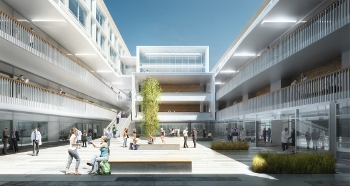Jun 6 2013
The David Geffen School of Medicine at UCLA, already among the best medical schools in the nation, is getting ready to break ground on a medical education building that will change the face of the school's teaching and learning efforts.
 Rendering of new medical education building (Image credit: Skidmore, Owings & Merrill LLP)
Rendering of new medical education building (Image credit: Skidmore, Owings & Merrill LLP)
The new five-story, 110,000 square foot Teaching and Learning Center for Health Sciences, to be built near the intersection of LeConte and Tiverton avenues, will allow the David Geffen School of Medicine to expand its educational programs and improve teaching and learning, and the facility is expected to be a boon for recruiting students, staff and faculty. Construction is scheduled to begin in September.
Funding for the $120 million project will come from the UCLA Health System reserves and philanthropic gifts. Plans call for environmentally friendly construction, and UCLA will apply for LEED certification.
"We're building this center not for just today," said Dr. A. Eugene Washington, UCLA vice chancellor for health sciences and dean of the Geffen School. "We're constructing an edifice we believe will help shape the future."
A desire to consolidate some of the medical school's teaching facilities — they currently span 11 buildings throughout South Campus — and emerging trends in medicine and medical education are among the key reasons for the new building. In particular, the building will be more conducive to instruction on team-based approaches to medical care and the increasing presence of mobile technologies for diagnosing, tracking and monitoring disease. "This project is critical because in educating the best and brightest, we want to provide the best overall learning experience for our students," Washington said.
The Teaching and Learning Center, which is expected to be completed in 2016, will feature technology-enabled classrooms to facilitate active learning, a clinical skills training center, innovative and flexible teaching labs that promote collaboration and interaction, as well as spaces for students to relax, room for student organizations to meet, and offices for admissions, financial aid, student affairs and other student services.
"We pride ourselves on being innovators in education," said Dr. John Mazziotta, associate vice chancellor of health sciences and executive vice dean of the medical school, adding that the building will become a much-needed hub for the school and serve as a spectacular entryway from the south into the campus. "To really be at the forefront, you also must have state-of-the-art facilities — the best classrooms, the best clinical and teaching centers, the best open spaces in which students can learn, and the best equipment."
The school's current classrooms were built over 60 years ago when lectures were the primary teaching method, said LuAnn Wilkerson, the school's senior associate dean for medical education. Since then, teaching has evolved in favor of activities that promote problem-solving, teamwork, interpersonal communication and computer simulations, she said.
"We strive to create a stimulating intellectual environment for students that emphasizes the importance of collaboration, curiosity and caring," said Wilkerson. "This forward-looking space will help us recruit the very best students and faculty who can use a wide variety of learning tools to educate themselves to meet the ever-changing societal need for health and health care."
The center will also enable students from all medical disciplines to work more closely together — an important feature given the increasing demand for multidisciplinary, team-based approaches to health care. For example, a new year-long seminar for third-year students in medicine, dentistry and advanced-practice nursing will allow them to work in groups of eight, along with two faculty members from the different schools, to address issues relevant to systems of health care and collaborative practice.
"The future is really about having doctors and nurses and dentists all together in the classroom much earlier on, so it's very much about interprofessional education," Washington said. "As we try to build a truly patient-centered approach to delivering medical care, that integration, which has been a big theme in medical schools, is going to be vital for our trainees. Our vision is to create world leaders in health, science and education. The environment in which that takes place in is very important."
The David Geffen School of Medicine at UCLA has more than 2,000 full-time faculty members, almost 1,300 residents, more than 750 medical students, and almost 400 Ph.D. candidates, and ranks in the top tier of research institutions funded by the National Institutes of Health.